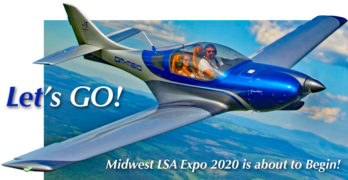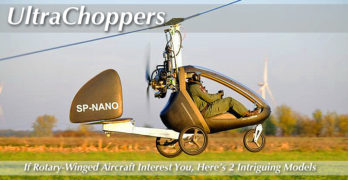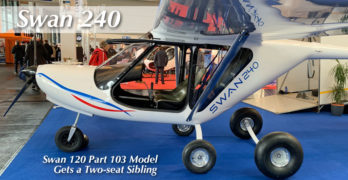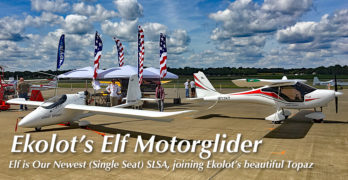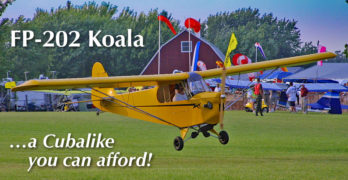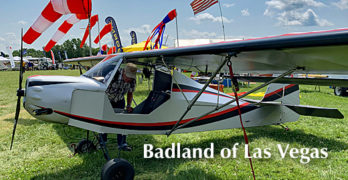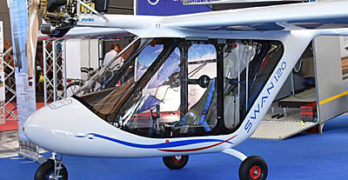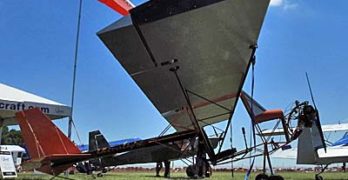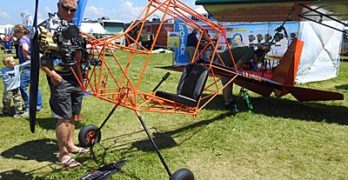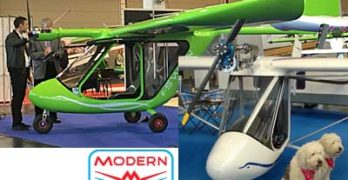I hope you can attend 2020’s Midwest LSA Expo — the last airshow in 2020. If you cannot attend, rest assured your trusty reporter will be onsite and gathering all the info on the coolest aircraft I can find.
What will be available? Well, if I am honest, we will have to see when we arrive to be certain. In these virus-impacted times, things have a lousy way of changing at the last minute, however…
Those who attend should see a few aircraft that few Americans have seen before. Here’s a quick take, not forgetting the statement about how arrivals can be altered beyond the wishes of any particular vendor.
Rare and/or New Aircraft
MC-01 by Montaer — We almost didn’t see it. Insurance has been getting harder to find and more costly. That’s true for all aircraft but the situation is especially challenging for a new design (even if it significantly resembles an earlier design).
Search Results for : Polini
Not finding exactly what you expected? Try our advanced search option.
Select a manufacturer to go straight to all our content about that manufacturer.
Select an aircraft model to go straight to all our content about that model.
UltraChoppers — Exploring Two Light Rotary-Winged Aircraft: 1 Helo + 1 Gyro
➡️ This article was UPDATED on July 31, 2020 with additional information — see after video…
Some pilots love to whirl their wings over their heads. Many others like the idea of rotary flight — offering short takeoffs and landings plus ease of operation in windier conditions. A majority have not (yet) acted on their interest but perhaps they are waiting for the right aircraft, maybe one of these.
One is a very light coaxial helicopter from Russia. The other is a single place gyroplane from Poland.
Micron-3 Coaxial Helicopter
Have a glance at the RD Heli’s Micron-3 ultralight helicopter. This is like no other ultralight helicopter I’ve ever seen, although the idea of coaxial is not new.
History suggests coaxial rotors originated with Mikhail Lomonosov a very long time ago, according to Wikipedia. Over the years, many helicopter models have emerged but none so compact as Micron-3
Coaxial rotors are a pair of helicopter rotors mounted one above the other driven by concentric driveshafts, with the same axis of rotation, but turning in opposite directions (contra-rotating; see graphic).
Swan Producer Adds Two-Seat Version to Popular 103-Compliant Ultralight Aircraft
We live in an age of sophisticated two seaters, a large flock of wonderful aircraft of every description. Such two-place flying machines lead in sales and perhaps that’s to be expected. Around 80% of light aircraft buyers prefer three-axis fixed-wing aircraft. This is hardly surprising as that’s what nearly all pilots have used for primary training since the ’70s.
To select another aircraft type means going out on a tree limb. This is especially true with what I call “alternative aircraft” — weight shift trikes, powered parachutes, motorgliders, and gyroplanes. It would include lighter-than-air, too, if we had more than a single entry.
However, some three-axis fixed wingers also disregard Part 103-compliant aircraft. Some say, “Those things are flying lawn chairs,” by which they try to disparage the category hinting they’re too “flimsy.” Most who say this probably never sat in one let alone flew one.
One entry I’ve written about (see my earlier report) appears to have be viewed differently, perhaps as it has a full enclosure and is built of composite materials.
Rare & Beautiful — Ekolot’s Elf Single Seat Motorglider Earns Special Light-Sport Aircraft
Welcome to the newest Special Light-Sport Aircraft …except that it isn’t so new(1). Indeed, we’ve seen the Ekolot Elf for a few years in this country. Here’s what I wrote on its introduction in 2017.
I was immediately drawn to Elf for two reason: One, I love soaring flight, which represents one of the most enjoyable challenges I’ve found in flying. “Hooking” a thermal and riding it thousands of feet upwards with the engine off or idling is not only magical; it’s also a good skill development exercise. Two, Elf was initially promoted as a Part 103, which I believe is aviation’s most charming — and certainly least-regulated — segment. Low prices, no pilot license required, no N-numbers, no medical of any kind …well, no wonder Part 103 aircraft are selling so well the last few years.
In Germany they have the “120-Kilogram Class,” meaning airplanes that weight no more than 264 pounds (very similar to the U.S.
Ultralight April 2020 — Third in the Vintage Series: Fisher FP-202 Koala
When Fisher was still located where it began, in North Dakota, I paid a visit to the factory. It may have been the tidiest wood shop I have ever seen.
I had just written an article about kit-builder assembly manuals so I was keen to see examples of Fisher Flying Products full-size plans. That always sounded like a marketing term yet I knew it meant exactly what they called it.
Darlene Hansen showed me a neatly-organized series of boxes full of long tubes of paper. She took one out, for the fuselage of the Koala as it turned out (see nearby image). She went to one end of a long, flat table and briskly unfurled the tube of paper while hanging on to the loose edge. It rolled and rolled …and rolled, until a sheet about four feet wide and 20 feet long covered the work table.
You literally take the tiny wood pieces Fisher ships to you as part of the kit and lay them directly on the paper as shown.
Badland Aircraft — Kitfox Lite, A True Part 103 Ultralight Aircraft, Returns to the Market
Once we had Avid Flyer. It begat Kitfox, which begat many models before returning to the starting point by creating a Part 103 ultralight vehicle* called Kitfox Lite …what else? At that time Kitfox was owned by its principal, Dan Denney.
A good marketer Denney’s Kitfox once employed a whole staff of sales people following up on loads of leads that the then-new design was generating. Even now, decades later, Kitfox, doing business as Fox Air, is building one of the most successful kit-plane designs in aviation history. (For the facts and market position of Kitfox visit our Tableau Public page of LSA and SP kit statistics.)
While the Dan Denney version of Kitfox Inc., addressed strong demand, they also began working to widen the market they served. Kitfox had found success as a two seater in various configurations but did a market exist for a single seater?
Swan Ultralight — “Big Little Airplane” in a Tiny Box (Trailer)
For three years at Aero Friedrichshafen, the wonderful April show in the south of Germany, I have admired one genuine ultralight called Swan.
Yes, “ultralight!” Swan may not look like a U.S. “ultralight vehicle” as Part 103 rule writers deliberately named the type. Yet I use the term with care. So does the Swan producer.
The company is well aware of three national standards with which Swan neatly complies, they said: England’s SSDR or Single Seat DeRegulated, or Germany’s 120-kilogram class or FAA’s Part 103. These are all surprisingly similar (see this article for more). Swan may need to be equipped carefully to achieve this but the producer assured me it was possible.
Naturally, I get that not everyone is into ultralights and/or single seat aircraft. However, interest appears stronger than in many years. No doubt many potential buyers look closely at purchase prices they can afford while for those lucky enough to afford two airplanes, Swan could be their “sport” airplane as some spam can works to haul the family around.
Sun ‘n Fun Day 2 — Just Aircraft Solo 103, LSA Mall, and DeLand’s Reception
After a damp opening day, the sun returned on day #2 at Sun ‘n Fun 2018. A beautiful blue sky was enjoyed by crowds that appeared to grow quickly. Many likely saw yesterday’s forecast and put off attending for that day. By the end of Wednesday, though, parking aircraft filled the grounds, nearly every one of 58 display spaces in Paradise was occupied, and campgrounds were reported so full that additional area was opened.
The LSA Mall hosted by LAMA also filled up to include quite an eclectic collection of light flying machines from a 140-pound twin-engine genuine Part 103 ultralight homebuilt (Lightning Bug), a one-of-two-in-the-USA motorglider to highly affordable choices, speedy LSA cruisers, and bush-ready aircraft.
DeLand Showcase, the new airshow in early November (1st-2nd-3rd in 2018) sponsored a reception and attracted a large crowd that was fed a wonderful meal, served drinks, and entertained by live music all within clear view of the light plane area turf runway.
Big to Small, Just Aircraft Pleases; Now, Check Out their Part 103 Ultralight Aircraft
If you know the Part 103 category of the FAA regulations, you know these are the lightest aircraft in aviation (that is, man-carrying aircraft; drones excepted).* After years of disappearing, Part 103 entries have come back more recently and at AirVenture Oshkosh 2017, we saw another.
This is the Just Aircraft Superlite, except that name was never certain and has (since Oshkosh) been taken off the list as a model name. Until they put a fresh name on it, I will call it Just 103.
Part 103, as most readers may know, requires no pilot certificate (really, none!). They also require no FAA registration or N-numbers. Since 1982, you need no aviation medical to fly one. Plus, they can be built ready-to-fly… or in kit form of any percentage. For 35 years now — the rule went effective in September of 1982 — Part 103 ultralight vehicles have been part of the aviation firmament.
Swan Ultralight Goes Both Ways: Electric & Gas
In my views of Swan at previous Aero Friedrichshafen shows, the design caught my eye as it was (a) a single seater, (b) light enough to qualify as a Part 103 ultralight or its European equivalents, and (c) as it was an all-composite, nicely designed aircraft. Commonly, Part 103-capable designs are much more basic to remain within the tight limits. This statement also applies to the German 120-kilogram category or to Britain’s Single Seat DeRegulated (SSDR) description.
As Aero contributor and Powered Sport Flying publisher Roy Beisswenger and I frequently discuss, the most likely place for electric propulsion to work today is in ultralights. This is because in very light aircraft with more local flying missions, battery weights for a modest period of flying (30-60 minutes) is already achievable in the very lightest of powered aircraft. We have been discussing this with FAA for more than three years.


